MY Bharat Aapda Mitras

- 02 Sep 2025
In News:
- In the wake of devastating floods in Punjab and Himachal Pradesh, the Union Minister of Sports and Youth Affairs, Dr. Mansukh Mandaviya, announced the deployment of over a thousand trained MY Bharat Aapda Mitras to aid ongoing rescue and relief efforts.
- The initiative underscores the government’s emphasis on community-based disaster response, leveraging trained youth volunteers to strengthen resilience at the grassroots level.
MY Bharat: An Overview
- MY Bharat is an autonomous body established by the Department of Youth Affairs, Ministry of Youth Affairs and Sports.
- It operates as a phygital (physical + digital) platform, connecting and mobilising India’s youth (aged 15–29 years) through volunteering, mentorship, experiential learning, and industry networks.
- The platform seeks to provide equitable access to opportunities, enabling youth to contribute to Viksit Bharat (Developed India).
Aapda Mitra Programme under MY Bharat
- The Aapda Mitra programme, implemented by the National Disaster Management Authority (NDMA), provides structured, NDMA-certified disaster response training to youth volunteers.
- Training modules cover:
- Search and rescue operations
- First aid and medical response
- Crowd management
- Emergency coordination
- These volunteers act as first responders, ensuring the timely supply of food, medicines, and relief material to communities cut off by floods, landslides, or cloudbursts.
Current Mobilisation for Punjab and Himachal Pradesh
- Thousands of Aapda Mitras are being deployed across the flood-hit districts of Punjab and Himachal Pradesh.
- Volunteers will work in coordination with District Magistrates, district administrations, and local authorities to ensure swift rescue and relief.
- Their role will be crucial in reaching remote villages, where connectivity has been disrupted due to floods and landslides.
Significance
- Strengthens community-led disaster resilience.
- Bridges the gap between formal institutions (NDMA, administration) and citizen response efforts.
- Provides a youth-centric model of disaster preparedness, integrating skill development with national service.
- Demonstrates the whole-of-society approach to disaster management by combining government resources, institutional training, and grassroots volunteerism.
Mission Mausam
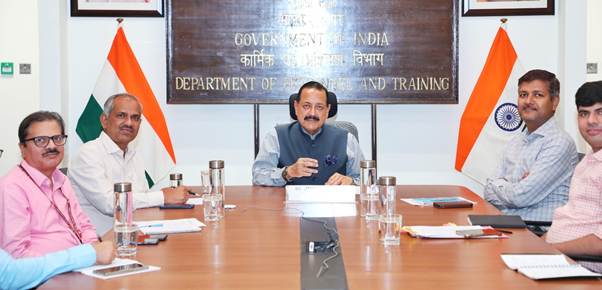
- 02 Sep 2025
In News:
The increasing frequency of extreme weather events—cloudbursts, flash floods, and landslides—has underlined the urgent need for robust forecasting and disaster management mechanisms in India’s Himalayan region.
In this context, the Indian Meteorological Department (IMD), under the Ministry of Earth Sciences (MoES), is set to install four additional radars in Jammu & Kashmir (J&K) as part of Mission Mausam (2024). This development coincides with intensified relief and rehabilitation efforts following unprecedented rainfall and floods in August–September 2025.
Mission Mausam: An Overview
- Launched: 2024 by the Ministry of Earth Sciences.
- Implementing Agencies: IMD, National Centre for Medium-Range Weather Forecasting (NCMRWF), and Indian Institute of Tropical Meteorology (IITM).
- Objectives:
- Enhance India’s forecasting capability across short, medium, extended, and seasonal scales.
- Develop high-resolution models for improved accuracy in monsoon prediction.
- Strengthen observational networks with radars, satellites, automated weather stations.
- Provide sector-specific advisories for agriculture, water resources, health, energy, and disaster management.
- Build capacity through national and international collaborations.
Significance: It represents a transformative milestone in India’s climate resilience strategy, supporting sustainable development, while safeguarding lives, livelihoods, and infrastructure.
Relief and Rehabilitation Measures in J&K (2025)
Following the cloudbursts and floods, the Centre and UT administration launched coordinated relief measures:
- Immediate Relief: Supply of rations, medicines, water filters, and medical kits. Additional consignments dispatched from MP funds to supplement government aid.
- Community Role: Civil society and local bikers acted as first responders, showcasing a whole-of-society approach.
Broader Relevance for Disaster Management
- Policy Linkages: Aligned with the Disaster Management Act, 2005 and the Sendai Framework (2015–2030), emphasizing early warning systems and community resilience.
- Socio-Economic Impact: Strengthening forecasting reduces agricultural losses, protects infrastructure, and prevents human casualties.
- Strategic Significance: Enhances preparedness in the fragile Himalayan ecosystem, prone to climate-induced disasters.
C-FLOOD
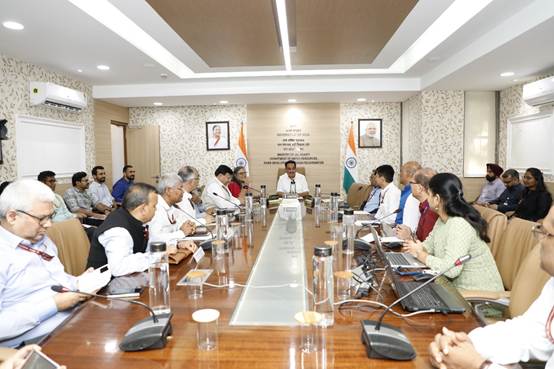
- 06 Jul 2025
In News:
In a significant advancement in disaster risk management, Union Minister of Jal Shakti Shri C.R. Patil inaugurated C-FLOOD, a Unified Inundation Forecasting System. Developed under the National Supercomputing Mission (NSM), C-FLOOD marks a pivotal step toward strengthening India's flood preparedness and mitigation strategy.
What is C-FLOOD?
C-FLOOD is a web-based, real-time flood forecasting platform designed to deliver two-day advance inundation forecasts at village-level resolution. It provides:
- Flood inundation maps
- Water level predictions
- Localized early warnings to support disaster response and planning.
Developing Agencies:
- Centre for Development of Advanced Computing (C-DAC), Pune
- Central Water Commission (CWC)
- National Remote Sensing Centre (NRSC)
Developed in collaboration with the Ministry of Jal Shakti, Ministry of Electronics & IT (MeitY), and Department of Science & Technology (DST).
Key Features:
- 2-Day Village-Level Forecasts: Localized and high-resolution predictions up to the gram panchayat level.
- Advanced 2-D Hydrodynamic Modelling: Simulations run on High-Performance Computing (HPC) systems under NSM.
- Multi-Basin Coverage: Initially operational in the Mahanadi, Godavari, and Tapi river basins, with future expansion planned.
- Unified Data Integration: Combines outputs from national and regional flood models into one platform.
- Disaster Portal Linkage: Designed for integration with the National Disaster Management Emergency Response Portal (NDEM).
- Climate-Adaptive Governance: Supports flood forecasting in regions vulnerable to climate-induced extreme weather events.
Strategic Importance:
- Disaster Risk Reduction: Enables timely warnings, efficient evacuations, and minimizes loss of life and property.
- Scientific & Operational Integration: Bridges hydrological modelling with on-ground responses.
- Supports Viksit Bharat @2047 Vision: Contributes to climate-resilient water governance.
- Promotes Inter-Agency Synergy: Encourages coordination among CWC, C-DAC, NRSC, and disaster management bodies.
Government Directions and Future Path:
During the inauguration, the Union Minister emphasized:
- Wide dissemination of C-FLOOD to enhance public awareness.
- Expansion to all major river basins through comprehensive inundation studies.
- Improved accuracy via satellite data validation and ground-truthing.
- Integration with NDEM for real-time emergency response.
The minister lauded the collaborative spirit of CWC, C-DAC, and NRSC, and reaffirmed the government's commitment to proactive and technology-driven disaster management.
Cell Broadcast System

- 03 Jul 2025
In News:
The Department of Telecommunications (DoT), in collaboration with the National Disaster Management Authority (NDMA), is piloting a Cell Broadcast (CB) system to enhance emergency communication and deliver real-time disaster alerts across India.
What is the Cell Broadcast System?
Cell Broadcasting is a telecommunication technology that enables mobile network operators to send geographically targeted text alerts to all mobile devices in a specific area. Unlike traditional SMS, CB messages are broadcast simultaneously to all phones within a cell tower’s coverage, ensuring instant delivery even during network congestion.
Key Features and Benefits:
- Instantaneous alerts during emergencies like earthquakes, tsunamis, lightning strikes, and industrial disasters.
- Indigenously developed by the Centre for Development of Telematics (C-DOT).
- Language inclusivity: Messages can be broadcast in multiple Indian languages.
- Particularly effective in high-density areas and during network overloads.
Integration with Existing Systems:
This CB system complements the existing Integrated Alert System (SACHET), which:
- Has delivered over 6,899 crore SMS alerts.
- Covers all 36 States and Union Territories.
- Supports 19 Indian languages.
- Is based on the Common Alerting Protocol (CAP) as recommended by the International Telecommunication Union (ITU).
Once fully deployed, the Cell Broadcast system will strengthen India’s disaster preparedness, ensuring wider, faster, and more inclusive dissemination of critical alerts.
DNA Identification in Mass Fatality Events
- 17 Jun 2025
In News:
Following the tragic crash of an Air India Boeing 787 Dreamliner from Ahmedabad to London Gatwick (June 2025), authorities have initiated DNA-based identification to match the remains of victims. In mass fatality incidents where bodies are mutilated or decomposed, DNA analysis becomes the gold standard for establishing identity.
What is DNA Identification?
DNA (Deoxyribonucleic Acid) is a unique genetic code present in almost every cell of the human body, with the exception of identical twins. It is widely used in forensic science for accurate identification, particularly in disasters where visual identification is impossible.
Sample Collection and Preservation:
- DNA begins degrading post-mortem, and the rate of degradation is influenced by:
- Type of tissue (soft vs hard)
- Environmental conditions (humidity, temperature)
- Hard tissues such as bones and teeth are preferred due to better preservation against decomposition.
- Soft tissues (like skin and muscle) degrade faster and, if used, must be stored in 95% ethanol or frozen at -20°C.
- In large-scale accidents, sample collection from wreckage can take weeks or even months (e.g., 9/11 took 10 months).
Reference Samples:
To match unidentified remains, reference DNA is taken from biological relatives—preferably parents or children of the victims, who share about 50% of their DNA.
Methods of DNA Analysis:
1. Short Tandem Repeat (STR) Analysis:
- Evaluates short, repeating DNA sequences that vary among individuals.
- Requires nuclear DNA, hence not suitable if the DNA is highly degraded.
- Analysis of 15+ hyper-variable STR regions can confirm family relationships with high accuracy.
2. Mitochondrial DNA (mtDNA) Analysis:
- Used when nuclear DNA is not recoverable.
- mtDNA is inherited exclusively from the mother and is present in multiple copies per cell.
- Effective for matching with maternal relatives (e.g., mother, maternal uncles/aunts, siblings).
3. Y-Chromosome Analysis:
- Targets male-specific genetic material.
- Useful for identifying remains using DNA from paternal male relatives (father, brothers, paternal uncles).
- Helpful when direct relatives are unavailable but male-line relatives exist.
4. Single Nucleotide Polymorphisms (SNPs) Analysis:
- Suitable when DNA is highly degraded.
- Analyzes variations at single base-pair locations in DNA.
- Can also match DNA with personal items like a toothbrush or hairbrush.
- However, less accurate than STR analysis.
Significance for Disaster Management and Forensics:
- DNA-based victim identification ensures scientific accuracy, aiding in closure for families, and upholding legal and humanitarian obligations.
- Modern forensic genetics has become an essential tool in mass disaster response protocols worldwide.
Black Boxes in Aviation

- 16 Jun 2025
In News:
The tragic crash of an Air India Boeing 787-8 Dreamliner from Ahmedabad to London Gatwick on June 12, 2025, has spotlighted the critical role of black boxes—a key component in aviation safety and accident investigations. Despite their name, these devices are painted bright orange for easy visibility at crash sites.
What are Black Boxes?
Modern aircraft are equipped with two essential flight recorders:
- Cockpit Voice Recorder (CVR): Captures pilot and co-pilot conversations, ambient cockpit sounds, alarms, and radio transmissions.
- Flight Data Recorder (FDR): Records up to 25 hours of technical flight data including altitude, speed, engine parameters, flight path, and over 3,500 variables.
These devices operate continuously without interruption, storing vital information that can reconstruct the events leading up to an air crash.
Design and Durability
Black boxes are built to withstand extreme conditions:
- Casing: Made from crash-resistant materials like titanium or steel.
- Survivability: Can endure temperatures up to 1,100°C, high-impact G-forces, and remain underwater for up to 30 days.
- Locator Beacon: Emit signals to help recovery teams locate them, especially in underwater crashes.
Why Are They Called 'Black' Boxes?
The term “black box” originated from early film-based recorders stored in light-tight boxes. However, modern units are painted bright orange with reflective strips to aid visual detection after accidents.
Evolution of Flight Recorders
- 1930s: François Hussenot in France developed early photographic film-based recorders.
- 1953-54: Dr. David Warren in Australia invented the modern FDR while investigating unexplained crashes of the de Havilland Comet.
- 1960: Mandatory installation of CVRs and FDRs in commercial aircraft.
- 1965: Regulators required recorders to be painted in visible colours.
- 1990: Solid-state memory replaced magnetic tapes, increasing durability and storage capacity.
India's Aircraft Accident Investigation Bureau (AAIB), under the Ministry of Civil Aviation, oversees accident probes. In April 2025, it established a dedicated flight recorder laboratory in New Delhi to improve investigation efficiency.
Technological Advancements
- Combined Recorders: Modern systems often integrate CVR and FDR in a single unit to meet ICAO norms for extended recording.
- Deployable Recorders: Automatically ejected during a crash, float on water, and transmit their location using an Emergency Locator Transmitter (ELT).
- Satellite-Based Data Streaming: Future technologies aim to stream flight data in real time, minimizing data loss during oceanic crashes.
Black boxes serve as the backbone of aviation accident investigations by providing critical insight into aircraft performance and crew actions before a crash. Their development reflects ongoing efforts to enhance air travel safety and accountability. The Ahmedabad crash investigation led by the AAIB will heavily rely on these devices to determine the exact sequence of events and prevent future tragedies.
INS Sharda

- 08 May 2025
In News:
The Indian Navy’s offshore patrol vessel, INS Sharda, has reached Maafilaafushi Atoll in the Maldives to participate in its first-ever Humanitarian Assistance and Disaster Relief (HADR) exercise, scheduled from May 4 to May 10, 2025.
Strengthening Regional Maritime Cooperation and Disaster Preparedness
This exercise is a key part of India’s strategic efforts to enhance regional maritime cooperation and bolster disaster readiness within the Indian Ocean Region (IOR). It underscores India’s steadfast commitment to its “Neighbourhood First” Policy, which recognizes the Maldives as a close maritime neighbour with deep strategic and cultural ties.
Aligning with the MAHASAGAR Vision
The HADR exercise supports the recently unveiled MAHASAGAR vision—Mutual and Holistic Advancement for Security and Growth Across Regions—introduced by the Prime Minister during the Mauritius visit. MAHASAGAR reaffirms India’s role as a net security provider and first responder in the Indian Ocean, building on the earlier SAGAR doctrine (Security and Growth for All in the Region). Both frameworks emphasize inclusive security, regional cooperation, and disaster resilience.
Objectives of the HADR Exercise
According to the Indian Navy, the exercise aims to:
- Enhance interoperability between the Indian Navy and the Maldives National Defence Force (MNDF).
- Conduct joint drills focusing on Search and Rescue (SAR), disaster response coordination, logistical support, and medical aid.
- Facilitate training programs for capacity building among personnel.
- Engage with local communities to raise awareness and strengthen disaster preparedness.
This maiden HADR exercise by INS Sharda marks a significant step toward deepening India-Maldives maritime collaboration and regional disaster management capabilities.
Disaster Management (Amendment) Bill, 2024
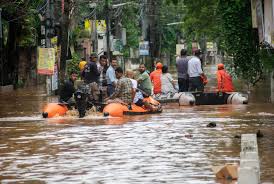
- 27 Mar 2025
In News:
The Parliament has passed the Disaster Management (Amendment) Bill, 2024, aiming to strengthen disaster response mechanisms.
Ministry: Home Affairs
Background
The Disaster Management Act, 2005 established a three-tier structure:
- National Disaster Management Authority (NDMA)
- State Disaster Management Authorities (SDMAs)
- District Disaster Management Authorities (DDMAs)
These bodies were responsible for disaster planning, mitigation, and response at national, state, and district levels respectively.
Key Amendments
1. Preparation of Disaster Management Plans
- Earlier: Executive Committees were responsible for preparing disaster plans.
- Now: NDMA and SDMA will directly prepare and approve national and state disaster management plans.
2. Expanded Functions of NDMA and SDMA
New responsibilities include:
- Periodic risk assessments, including risks from climate-related events.
- Technical guidance to lower-level authorities.
- Minimum standards of relief recommendations.
- Creation of disaster databases containing:
- Disaster risk profiles
- Fund allocations and expenditures
- Preparedness and mitigation strategies
- NDMA-specific roles:
- Assessment of state preparedness
- Post-disaster audits to evaluate response effectiveness
3. Urban Disaster Management Authorities (UDMAs)
- To be established in state capitals and municipal corporation areas.
- Composition:
- Chairperson: Municipal Commissioner
- Vice Chairperson: District Collector
- Additional members as per state government notification
- Responsible for urban disaster planning and implementation.
4. State Disaster Response Force (SDRF)
- States are empowered to establish SDRFs for specialized disaster response.
- Functions and service conditions to be defined by state governments.
5. Statutory Status to Key Committees
- National Crisis Management Committee (NCMC):
- Nodal body for major national disasters
- Chaired by the Cabinet Secretary
- High-Level Committee (HLC):
- Sanctions financial assistance to states
- Chaired by the concerned Union Minister
6. NDMA Staffing and Appointments
- NDMA can determine the number and type of officers and staff.
- Can appoint experts and consultants with prior central government approval.
Rationale Behind the Amendment
- Climate Change: Increased frequency of extreme weather events necessitates proactive strategies.
- Decentralization Gaps: States faced implementation challenges under the 2005 Act.
- Institutional Strengthening: Clearer roles for national and sub-national bodies.
- Technology and Data Integration: Emphasis on real-time data and performance audits.
Key Concerns and Criticism
- Centralization of Power:NDMA’s enhanced role may reduce state autonomy in disaster response.
- Overlap with State Authority:Potential encroachment on state disaster planning and fund utilization.
- Delayed Relief via NDRF:Increased central oversight may slow localized relief efforts.
- Omission of Emerging Threats:Excludes disasters like heatwaves from official definitions.
- Lack of State-Specific Relief Funds:Demand for region-focused financial provisions by states like Bihar.
Way Forward
- Ensure Federal Balance: Maintain cooperation between Centre and states.
- Update Definitions: Include climate-induced disasters like heatwaves.
- Transparent Funding Mechanism: Clear protocols for fund allocation and usage.
- Empower Local Bodies: Strengthen DDMAs and UDMAs through training and resources.
- Institutional Audits: Regular post-disaster audits to enhance future readiness.
Pink Fire Retardant
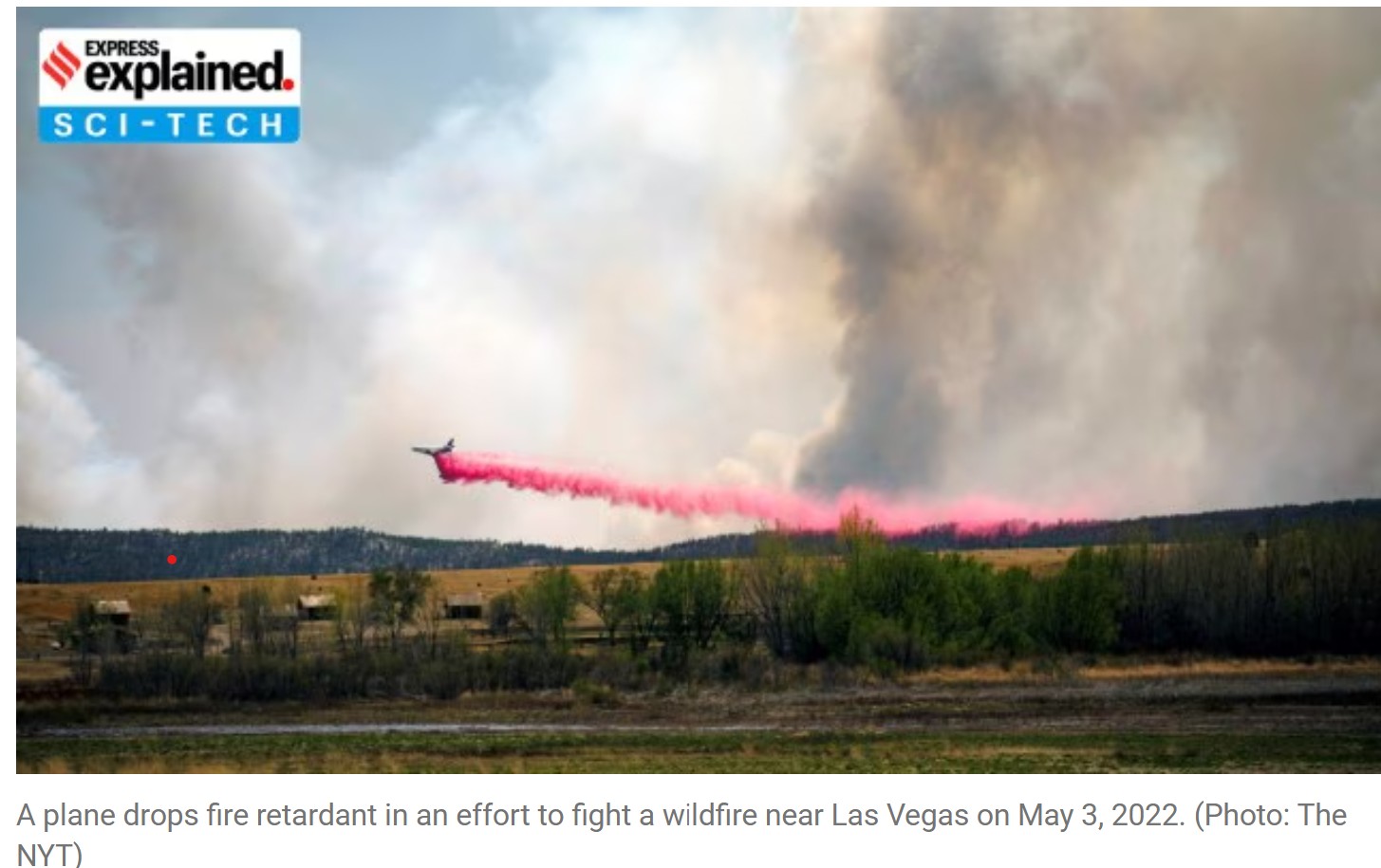
- 13 Jan 2025
In News:
As wildfires continue to rage across Southern California, authorities are deploying pink fire retardant from aircraft to help combat the blazes. Despite its widespread use, concerns over its effectiveness and environmental risks have surfaced in recent years.
What is Pink Fire Retardant?
- Fire retardant is a chemical mixture designed to slow down or extinguish wildfires. The most commonly used product in the U.S. is Phos-Chek, a brand of retardant.
- Phos-Chek primarily contains ammonium phosphate-based slurry (salts like ammonium polyphosphate), which helps the retardant stay longer and resist evaporation, unlike water.
Purpose and Visibility
- Fire retardants are sprayed ahead of fires to coat vegetation, reducing oxygen and preventing flames from spreading.
- Color is added to the fire retardant, often bright pink, to improve visibility. This ensures firefighters can track its spread and create effective fire lines, helping protect lives and property.
Manufacturer
- Perimeter Solutions manufactures Phos-Chek, which is used for aerial fire suppression efforts.
Effectiveness of Pink Fire Retardant
Limited Effectiveness
- The use of fire retardants like Phos-Chek is not always effective across different wildfire conditions.
- Aerial retardants depend on environmental conditions like terrain, slope, and weather for optimal effectiveness.
- Researchers, including Forest Service scientists, suggest that retardant effectiveness is more limited under changing climate conditions.
- Climate change is narrowing the window of opportunity for using aerial retardants, reducing their impact.
Uncertainty in Impact
- The effectiveness of fire retardants is hard to quantify. Multiple firefighting methods are used simultaneously, making it difficult to attribute wildfire suppression success solely to the retardant.
Environmental Concerns of Pink Fire Retardant
Toxicity and Pollution
- Phos-Chek contains toxic metals such as chromium and cadmium, both of which are harmful to humans and the environment.
- Chromium and cadmium are linked to serious health issues, including cancer and liver/kidney diseases.
- Aquatic life is particularly vulnerable to these toxins, as the chemicals can enter waterways, causing extensive damage to ecosystems.
Impact on Rivers and Streams
- The use of pink fire retardant has raised concerns regarding the contamination of rivers and streams.
- A study by the University of Southern California (USC) in 2024 estimated that 850,000 pounds of toxic chemicals have been released into the environment since 2009 due to fire retardant use.
Growing Use and Pollution
- From 2009 to 2021, over 440 million gallons of retardant were applied across U.S. lands.
- During this period, an estimated 400 tons of heavy metals were introduced into the environment, further exacerbating the pollution levels.
Financial and Practical Concerns
High Cost and Inefficiency
- The cost of deploying fire retardant is significant. Aerial firefighting operations require substantial resources, including planes, helicopters, and large quantities of retardant.
- Environmental experts argue that using fire retardant from planes is ineffective and expensive, especially in light of the growing environmental concerns.
Disposal of Toxic Waste from Union Carbide Factory (Bhopal)
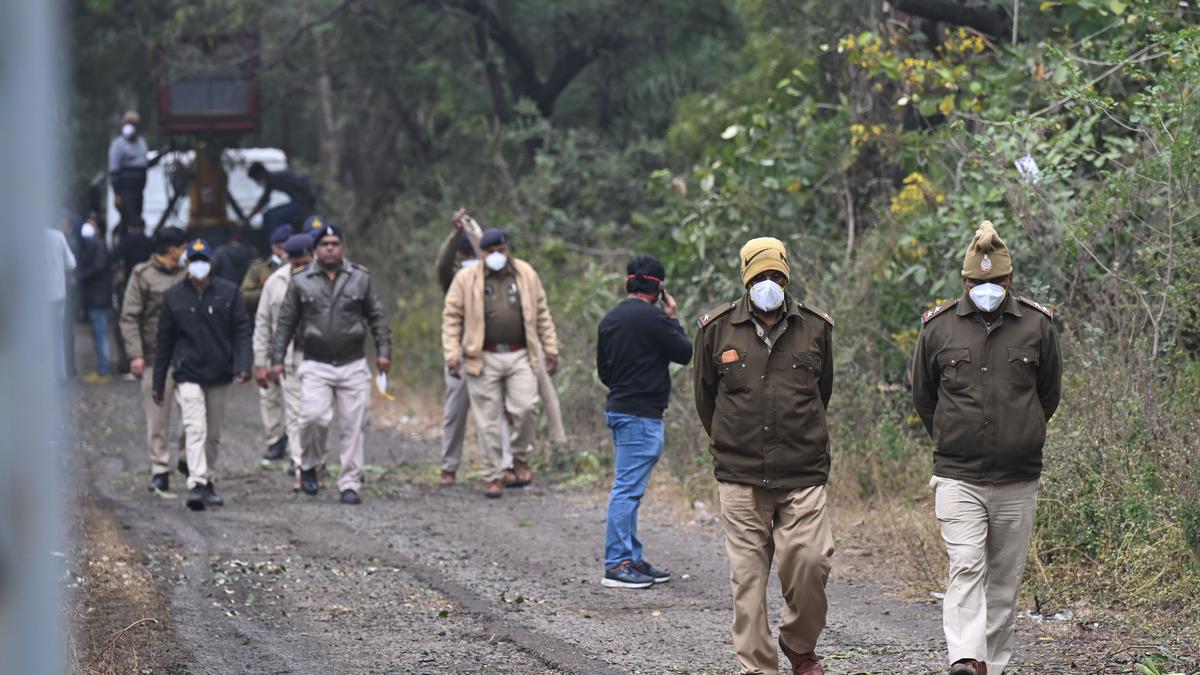
- 07 Jan 2025
In News:
The Madhya Pradesh government has begun disposing of the 337 tonnes of toxic waste from the premises of Union Carbide India Limited (UCIL) in Bhopal, 40 years after the gas tragedy.
Key Highlights:
- Packing and Transportation:
- Waste is packed in airtight containers under the supervision of the Central Pollution Control Board (CPCB) and Madhya Pradesh Pollution Control Board (MPPCB).
- 12 specially designed airtight containers are being used for packing, and each container will be loaded onto trucks for transport.
- The waste movement will be escorted with a green corridor of about 250 kilometers.
- Incineration Process:
- The waste will undergo incineration in Pithampur, with residue stored in a two-layer membrane landfill to prevent contamination.
- A trial incineration of 10 tonnes of the waste was done in 2015 with no harmful effects, and results were submitted to the High Court.
Bhopal Gas Tragedy: A Historical Overview
- About the Tragedy:
- In 1984, a chemical leak at the Union Carbide pesticide plant released methyl isocyanate (MIC), leading to one of the worst industrial disasters in history.
- The leak was caused by a failed maintenance attempt and malfunctioning safety systems.
- Immediate effects included respiratory issues, eye problems, and abdominal pain, while long-term effects included chronic lung conditions, genetic abnormalities, and higher infant mortality rates.
- Legal and Government Response:
- In 1985, the Indian government passed the Bhopal Gas Leak Disaster Act to represent victims in legal claims.
- UCIL initially offered USD 5 million, while the Indian government demanded USD 3.3 billion. The case was settled in 1989 for USD 470 million.
- In 2010, seven Indian nationals were convicted for causing death by negligence, but were released on bail.
Hazardous Waste Management in India
- Definition and Types:
- Hazardous waste refers to waste that poses significant risks due to toxicity, reactivity, or corrosiveness.
- Common sources include chemical production, outdated technologies, and wastewater treatment.
- Regulations and Disposal Methods:
- The Environment Protection Act (1986) and the Basel Convention (1992) govern hazardous waste management in India.
- India generates about 7.66 million tonnes of hazardous waste annually, with the majority being landfillable (44.3%) and recyclable (47.2%).
- Disposal methods include incineration, co-processing in cement plants, and material/energy recovery.
- Challenges in Hazardous Waste Management:
- Inadequate treatment technologies, especially in small and medium industries.
- The need for stricter compliance with waste management laws and more efficient remediation of hazardous sites like Bhopal.
1984 Bhopal disaster

- 04 Dec 2024
In News:
Forty years after the Bhopal disaster on December 2-3, 1984, several hundred tonnes of toxic waste still remain around the ill-fated Union Carbide plant.
Overview of the incident:
The 1984 Bhopal disaster, one of the world’s worst industrial accidents, was caused by the release of methyl isocyanate (MIC) gas, which was a key component in the production of pesticides at the Union Carbide India Limited (UCIL) plant. However, the toxic legacy of the disaster extends far beyond MIC, with a range of other harmful substances lingering in the environment. These include:
- Methyl Isocyanate (MIC):Primary toxic agent: MIC is a highly toxic, volatile compound. Exposure can cause severe respiratory distress, eye irritation, pulmonary edema, and even death.
- Heavy Metals:The site of the plant is contaminated with various heavy metals, including:
- Mercury: Known to accumulate in the body and affect the nervous system, kidneys, and liver. Even small doses over time can lead to chronic health problems.
- Chromium: Exposure to high levels of chromium, particularly hexavalent chromium, is associated with lung cancer and damage to the respiratory system.
- Lead: A potent neurotoxin, lead can cause developmental delays, memory problems, and damage to the kidneys.
- Nickel: Can cause respiratory and lung cancers when inhaled in significant quantities.
- Copper: High levels of copper exposure can damage the liver and kidneys.
- Organic Compounds:Several organic chemicals were found at the site, including:
- Hexachlorobutadiene: A suspected carcinogen that can cause liver damage, kidney damage, and neurological issues upon exposure.
- Chloroform (Trichloromethane): Known for its effects on the central nervous system, exposure can lead to dizziness, loss of consciousness, and even death at high concentrations. It is also a possible carcinogen.
- Carbon Tetrachloride: A potent liver toxin, exposure can result in liver damage, cancer, and nervous system toxicity.
- Trichlorobenzene: These compounds are volatile and can spread through air and water, accumulating in fatty tissues and causing damage to organs like the liver and kidneys.
- Persistent Organic Pollutants (POPs):Some of the contaminants, particularly the organic compounds, are classified as persistent organic pollutants, which do not degrade easily in the environment. These can lead to:
- Cancer: Several of these compounds are carcinogenic.
- Neurological damage: Prolonged exposure can affect both the central and peripheral nervous systems.
- Reproductive and developmental disorders: Exposure has been linked to adverse effects on fertility and developmental health in humans.
- Environmental and Long-term Health Effects:
- Even decades later, contamination continues to affect the health of people living around the site, with high rates of cancers, birth defects, respiratory diseases, and other health issues. Water sources in the region remain unsafe due to heavy contamination with toxic chemicals. Persistent organic pollutants have been identified in local communities, indicating that the contamination continues to spread.
Asia-Oceania Meteorological Satellite Users' Conference (AOMSUC-14)

- 02 Dec 2024
In News:
The 14th Asia-Oceania Meteorological Satellite Users' Conference (AOMSUC-14)was held in New Delhi, India, hosted by the India Meteorological Department (IMD) under the Ministry of Earth Sciences. This annual event brings together meteorologists, earth scientists, and satellite data users to discuss advancements in satellite technology for weather and climate monitoring.
Key Facts:
- Objective:
- Promote Satellite Observations: Highlight the importance of satellite data for meteorology and climatology.
- Advance Remote Sensing Science: Foster advancements in satellite technology and its application in weather forecasting and climate monitoring.
- Encourage Collaboration: Facilitate dialogue between satellite operators and users to enhance the use of satellite data across the Asia-Oceania region.
- Discuss Future Plans: Update on the current status and future plans of international space programs.
- Engage Young Scientists: Encourage the involvement of young researchers in satellite science and meteorology.
- Participants:
- Around 150 participants from various countries, including key international space organizations like WMO, NASA, ESA, JAXA, and other meteorological and space entities.
- The conference will feature oral presentations, poster sessions, panel discussions, and a training workshop focused on satellite data application.
- Significance of the Conference:
- Regional Cooperation: AOMSUC promotes stronger cooperation between countries in the Asia-Oceania region, addressing shared challenges in meteorology and satellite data usage.
- Improved Forecasting: Enhances satellite data utilization for more accurate weather forecasting, disaster prediction, and climate monitoring.
- Disaster Risk Management: Strengthens early warning systems for extreme weather events, improving disaster preparedness and response.
- Capacity Building: Offers training and workshops for local meteorologists, boosting the capacity of countries to use satellite data effectively for weather forecasting and climate services.
- Data Sharing: Encourages collaboration in satellite data sharing, facilitating better access to meteorological data across national borders.
- History of AOMSUC:The first AOMSUC was held in Beijing, China in 2010. Since then, the conference has been held annually in various Asia-Oceania locations and has become a leading event for the meteorological community.
SanyuktVimochan 2024
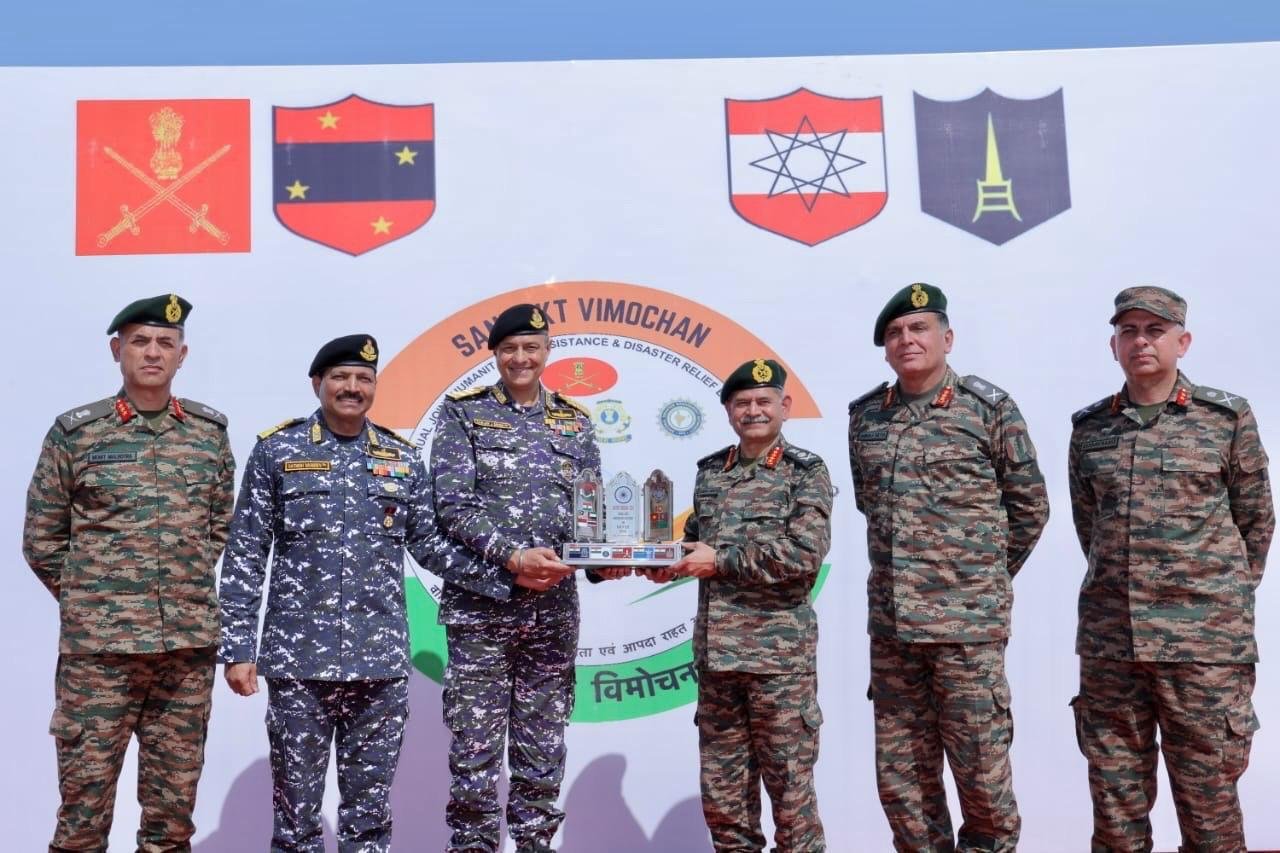
- 20 Nov 2024
In News:
Recently, the Indian Army successfully conducted the Multilateral Annual Joint Humanitarian Assistance and Disaster Relief (HADR) Exercise, 'SanyuktVimochan 2024' at Ahmedabad and Porbandar, Gujarat.
Key Highlights:
- Conducted by: Konark Corps of Southern Command, Indian Army.
- Day 1: Tabletop Exercise (TTX)
- Theme: 'Cyclone in Coastal Region of Gujarat'.
- Focused on simulating a cyclone scenario affecting the Okha-Porbandar coastline.
- Discussed disaster relief strategies and interagency cooperation to improve response readiness.
- Attended by senior officials from NDMA, Armed Forces, State Disaster Management, and industry representatives, including delegates from nine foreign countries.
- Day 2: Multi-Agency Capability Demonstration
- Held at Chowpatty Beach, Porbandar.
- Simulated Disaster Scenario: Coordinated response to a cyclone, showcasing joint operations by:
- Indian Army, Navy, Air Force, Coast Guard, NDRF, SDRF, and other Central and State agencies.
- Key actions demonstrated:
- Requisition and Surveillance: Civil administration’s request for Armed Forces' assistance, followed by area surveillance.
- Rescue Operations: Insertion of personnel to rescue casualties.
- Casualty Evacuation: Use of resources to evacuate and assist victims.
- Resuscitation and Rehabilitation: Restoration efforts for affected citizens.
- Industrial Display &Atmanirbhar Bharat Initiative:
- Showcased indigenous HADR equipment from Indian defense industries.
- Highlighted technological advancements and self-reliance in disaster management.
- SanyuktVimochan 2024 enhanced India's disaster response capabilities, ensuring a coordinated and effective approach to humanitarian assistance.
- The exercise also bolstered India’s leadership in global disaster relief, contributing to international best practices and collaborative efforts in humanitarian assistance and disaster response.
